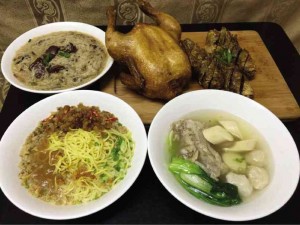
In Chinese cuisine, the pickings are so diverse and interesting that there seems to be a dish to match my every craving. This week, I had Chinese food three times and not once was there a flavor that was even remotely similar.
Lung Hin or “Dragon Pavilion” is one of my new favorite places. Located in Marco Polo Hotel in Ortigas Center, Lung Hin (tel. 7207777 loc. 6621) is not your typical Chinese restaurant. It offers a refreshing blend of traditional, authentic Cantonese food with a touch of foreign flavors and modern flair, prepared by Hong Kong chefs.
Ingenuity was evident in Three Flavored Prawns, succulent prawns coated in batter, fried and tossed in blueberry, salted egg and sakura sauces. I found this dish most interesting because the palate will never tire of it—three flavors in one, all so different from the other.
Nothing close to it
If you love to eat pigeon, you must head over to Choi Garden at 12 Annapolis St., Greenhills (tel. 7276042, 7277489 or 7245343).
There is nothing close to Choi’s Pigeon—it is perfectly marinated, so juicy, moist, succulent with the skin golden brown and wonderfully crisp. Few gustatory pleasures match the deliciousness of each bite.
I also liked the Fried Crabs with Hong Kong Chili Garlic Sauce—garlicky, aromatic, spiced and flavorful. My friend Mark Reyes nibbled on it from the time it was served until the restaurant was about to close. Even the garlic crumbs were flavorful.
The pig-shaped buns that I had for dessert were to die for. It was the best part of my meal. Each piece looked so cute and tasted so delicious. Imagine a soft mantou stuffed with a runny, buttery salted egg custard—absolutely delectable!
‘Mahkut’
Ana Lee, owner of Chef Yu Food House in Valenzuela, is the lady whose congee buffet ranks in my top 10 best comfort foods. The rather simple porridge transforms itself into a lavish feast when garnished with over 20 toppings. There is, however, more to her repertoire than just congee.
What Lee whips up are mostly heirloom recipes that her father, Yu Chu Hio, used to cook for their family when Ana was growing up.
I have tried many variations of mahkut, but Ana’s was not quite as I knew it. Like nilaga but always made of pork spareribs (mahkut), it is a staple dish among many Filipino Chinese families.
Ana recounted how her father would always bring home leftover cuts of pork spareribs from the meat stall where he worked. He would slow-boil the cuts with radish, the way the dish is typically cooked.
“I would know that he had a good day with his buddies at the mahjong table if our mahkut was topped with homemade fish balls and an egg custard sausage,” she said.
The egg custard sausage was handmade by her father. He would stuff the egg mixture into pig’s intestines.
It is now Ana’s mother Tan Piak Sian who helps her make the egg sausages. Though simple in flavor, it is quite a treat. Cooking it for hours over charcoal really makes a difference.
I enjoy mahkut best with fried garlic, fish sauce and chilies.
Like the mahkut, Lee’s kikiam was not like the ones I was familiar with. Hers had a rather different consistency—chewy, deep and complex in taste. It is the kikiam that her grandparents used to eat.
Sisig noodle soup
Ana also recalled how her dad made such big batches that would last for weeks. “I always stood nearby and watched him with fascination. He sliced all the ingredients from the pork, pork liver and vegetables by hand and patiently rolled them in tawpe (bean curd skins). This remains my family’s favorite comfort food.”
Chef Yu’s fried chicken is a hit, even in my home. I served this during one of our family dinners and everyone loved it.
The secret is to buy it at its ready-to-fry state and cook just before serving. I keep a few of them in my freezer. Whenever I feel lazy, I thaw the chicken and then deep-fry it.
Ana mastered this recipe because her son Kenneth once wanted nothing but fried chicken. Through the years, she kept working on the recipe until, one day, she hit the mark with sheer perfection—juicy, tasty inside and out.
Now this dish is interesting—imagine curds of silky, soft blood on your misua soup. The blood does not prominently figure in the overall taste of the soup but gives it texture and character. The protein rich soup is served for breakfast or merienda.
I found the Sisig Noodle Soup quite intriguing. It’s a cross between the famous Naga kinalas noodle soup and the old-time favorite sisig. This was born out of the many summers Ana spent in Naga City with her maternal grandmother Go Qui Ty.
Aside from savoring her lola’s food, she also enjoyed the next-door carinderias that served noodle soups, locally called kinalas. It consists mainly of chopped meat from the maskara (pig’s face) over a heap of noodles and a rich, slow-cooked soup stock.
Ana’s version was different from what was done in Naga; it was distinctly her own, applying other cooking techniques and adding a few other ingredients to make it even heartier. It is enjoyed with garlic, chilies and calamansi.
She even makes a beef sisig noodle, made with chopped bulalo meat and beef stock.
Chef Yu is the place to visit if you are in search of Chinese, with a touch of Filipino and a sprinkling of dishes that are uniquely different.
Chef Yu Foodhouse, Unit 10 Danding Bldg., Cecilio J. Santos St. Poblacion Malinta, Valenzuela City; tel. 2948788, 9986889